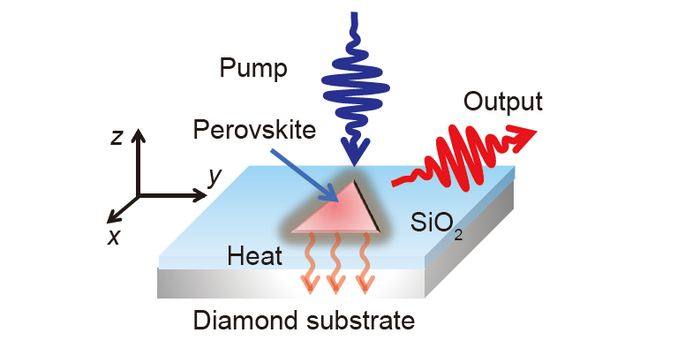A crucial step towards electrically excited lasing has been made with perovskite lasers in the development of continuous-wave excited lasing from femtosecond pulse excited lasing. Establishing electrically driven lasing is the next objective after continuous-wave lasing at ambient temperature.

The figure shows the schematic of the proposed optically pumped MAPbI3 whispering gallery mode (WGM) laser comprising a triangular MAPbI3 nanoplatelet, a SiO2 gap layer, and a diamond substrate. Image Credit: Science China Press
Traditional epitaxial-produced single-crystal semiconductors with substantial thermal conductivity κ and high charge carrier mobility m often display minor resistive heating under large current flow in commercially available electric injection lasers. Perovskites have small κ values while having substantial and balanced charge carrier mobilities.
Compared to GaAs, which have a thermal conductivity of 50 W m–1 K–1, MAPbI3 has a thermal conductivity of just 1–3 W m–1 K–1. As a result, heat generated due to energy loss via nonradiative pathways cannot be properly dispersed.
Due to the population inversion of any particular transition being diluted and other issues like deterioration and heat-induced flaws, this failure will raise the lasing threshold since carriers inhabit a wider energy range at a higher temperature. A distributed-feedback (DFB) perovskite laser’s lowest electric excitation threshold could reach 24 mA cm–2.
The external quantum efficiency would also be severely constrained under high current injection settings due to Joule heating in traditional perovskite light-emitting diode designs utilized for laser systems. Therefore, heat control is a barrier to the advancement of electrically powered perovskite lasers.
In this context, a team of researchers led by Professors Kaibo Zheng of Lund University and Guohui Li of the Taiyuan University of Technology demonstrated a perovskite nanoplatelet laser on a diamond substrate that can effectively dissipate heat produced during optical pumping. The laser being displayed has a Q factor of ~1961 and a lasing threshold of 52.19 μJ cm–2.
The addition of a thin SiO2 gap layer between nanoplatelets and the diamond substrate also results in a tight optical confinement. Electric field distributions inside the structures reveal that a broad SiO2 gap with a thickness of 200 nm evidently results in a reduced leakage field in the diamond substrate, while also suggesting improved mode confinement within the MAPbI3 nanoplatelet.
Temperature changes under optical pumping circumstances were used to measure the heat dissipation in perovskite nanoplatelet lasers on the diamond substrate.
Due to the inclusion of the diamond substrate, the laser has a low pump density-dependent temperature sensitivity (~0.56 ± 0.01 K cm–2 μJ−1). The sensitivity is between one and two orders of magnitude less than the values for perovskite nanowire lasers on glass substrates that have previously been reported.
The nanoplatelet laser can run at a high pump density owing to the diamond substrate’s high thermal conductivity. The study could serve as an inspiration for the creation of electrically powered perovskite lasers. SCIENCE CHINA Materials published this work.
The study was supported by Shanxi-Zheda Institute of Advanced Materials and Chemical Engineering Program (2022SX-TD020), the Natural Science Foundation of Shanxi Province (20210302123154 and 20210302123169), the Research Project Supported by Shanxi Scholarship Council of China (2021-033), the Research Project Supported by Shanxi-Zheda Institute of Advanced Materials and Chemical Engineering (2021SX-FR008), and the Introduction of Talents Special Project of Lvliang City (Rc2020206 and Rc2020207). Guohui Li also acknowledges the support from China Scholarship Council (202006935009, National Natural Science Foundation of China (U21A20496, 61922060, 61775156, 61805172,12104334, 62174117, and 61905173), and the Key Research and Development Program of Shanxi Province (202102150101007).
Journal Reference
Li, G., et al. (2023) Efficient heat dissipation perovskite lasers using a high-thermal-conductivity diamond substrate. Science China Materials. doi:10.1007/s40843-022-2355-6.